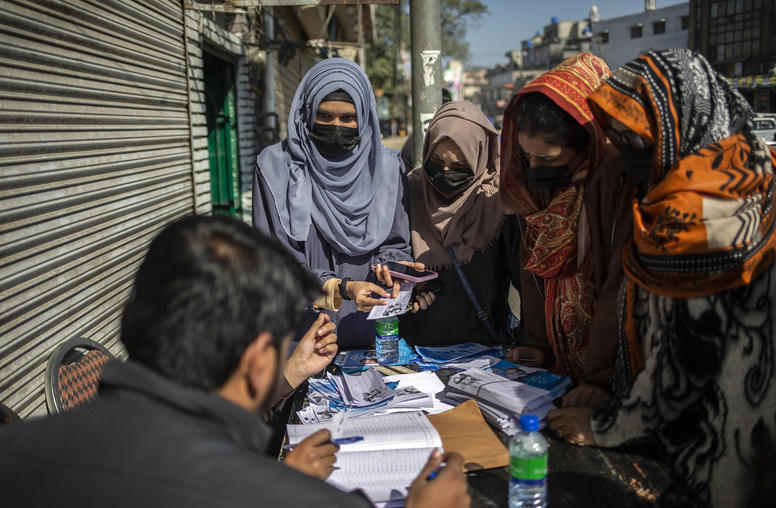Building Peace and a Partnership with the Military
We asked USIP leaders, from board members to senior staff and experts to explain the effect that events around the world and here at home will have on the U.S. and the contributions the Institute can and does make during a time of tremendous challenge – and opportunity. USIP Chief of Staff Retired Col. Paul Hughes served nearly 30 years on active duty with the Army.
This past year offered fresh proof that the world we live in is ever dynamic. Fundamental change can come from something as extraordinary as a fruit vendor’s act of defiance in Tunisia to popular revolts by reform movements fueled by the collective need for change across the Middle East. At the same time, a decade of war and weakened economies in many countries require new thinking about the role the U.S. will play in the world in the coming years.
We asked USIP leaders, from board members to senior staff and experts to explain the effect that events around the world and here at home will have on the U.S. and the contributions the Institute can and does make during a time of tremendous challenge – and opportunity.
Hughes served nearly 30 years on active duty with the Army. He was the director for strategic policy for the Office of Reconstruction and Humanitarian Assistance, and later was assigned to the Coalition Provisional Authority in Iraq. From 2000 to 2002, he was director of national security policy on the Army staff. Prior to that, he led the Office of the Secretary of Defense’s participation in crafting U.S. landmine policy as well as the Defense Department’s response to Hurricane Mitch, the Turkish earthquakes and the Mozambique floods. He has been awarded numerous campaign and service medals including three Bronze Stars.
As a retired military officer, some would argue you have spent a career helping to build or maintain peace around the world. Now as the chief of staff at USIP, how do you define “peacebuilding,” and how does it align with what the military does?
When I was commissioned as a second lieutenant in 1975 and assigned to Korea, there was not much awareness of peacebuilding, what it is or how it’s done. We were in the midst of the Cold War during an era of “violent peace.” Peacebuilding at the time was seen as an idealistic activity. At the time, our long-term strategy of containment and deterrence sought the collapse of the Soviet Union, but it also built a mindset of enduring confrontation. Within the military – and I believe the U.S. government -- we lost sight of the truth that the conclusion of any conflict is the reestablishment of peace. As a result, peacebuilding wasn’t widely recognized as a profession or field, either in theory or practice. To the degree that it was, it was marginal. I saw how ineffective various attempts at nation-building processes were for military personnel. If one looked at our efforts to stabilize Panama City after our 1989 invasion, for example, one would see many of those mistakes repeated in Iraq in 2003.
When I joined the Institute in 2005, I was impressed at how much had changed since the end of the Cold War. The Institute, working with the Defense Department, State, USAID, NGOs and colleges and universities, had built a foundation for the development of an emerging profession of experts in an organization focused on enhancing national security that was building new capabilities to deal with conflict and working hard to reduce costs to the American people. Today, after a decade of war, the coordination between the military and civilian agencies has improved enormously, even if it’s not yet where it needs to be.
War is part of the human condition. Why is this issue so important now?
The wars in Afghanistan and Iraq have cost American taxpayers $1.5 trillion—or about the same as the current annual federal budget deficit. On an individual level, a war’s cost in lives, of civilians and American service men and women, are incalculable. And the costs endure for years to come afterward, from reconstruction costs to caring for our war wounded to restoring our own economic vitality. Ample research backs this up. The commitment of our military to any war constrains our nation’s strategic flexibility because we often commit so much of our power to the conflict for an extended period of time. If we could resolve more conflicts without resorting to violence, we could save our limited resources for those times when we really need it.
So the question isn’t whether we can afford peacebuilding, but whether we can afford not to embrace it. Because as a new profession, it needs constant work to professionalize and improve it. We can pay enormous amounts in blood and treasure for war. We can pay far less by working to prevent or end conflict using proven techniques.
What have we learned from our interventions in Iraq and Afghanistan?
The nation can now plan for and execute the “post-conflict mission” better today than ever before. That’s due in part to some of the work done in recent years to create a “how-to guide” for the post-conflict environment. For example, one of USIP’s most important contributions to national security has been its collaboration with the Army on writing a how-to guide for stabilization and reconstruction. I think “Guiding Principles for Stabilization and Reconstruction” captures well the hard-won lessons of interventions using all government agencies working in concert to build the peace after the bullets stop flying. I think it is an extremely practical guidebook for adaptive, creative leadership at that most important juncture: when a conflict concludes. It was used for Libya, for example, as Libyans planned for the environment after Moammar Qaddafi was ousted.
The Institute also facilitates the “Working Group on Civil-Military Relations in Non-Permissive Environments,” the nation’s only regular working group between major U.S. humanitarian assistance NGOs, the Defense and State departments, and USAID. This group negotiated and oversees guidelines approved by the secretary of defense and the chairman of the Joint Chiefs of Staff to coordinate the relations and combined efforts of the military, civilian agencies and NGOs in peace and stability operations. It’s a work-in-progress, but at least today we are way ahead of where we were in 2003 when it comes to managing the interagency during conflict—and afterward, too.
Can you share an example of a conflict in which USIP has contributed significantly to building the peace over the past year?
In many ways, USIP embodies the emerging idea of what a national security agency should be: it's small, nimble and generates high impact for low cost. With just a $39 million budget and a staff of no more than 300 international conflict mediators, trainers and analysts, its operating model is simple. Since 9/11, USIP has enhanced America’s capability for peace and security in conflict zones like Iraq, Afghanistan, Sudan, the Balkans, the Philippines, Haiti, Nepal, and Nigeria.
USIP’s operations in Libya are the most recent example of what we do and how we do it. On a tactical level, USIP deployed its peacebuilders shortly after the NATO decision to intervene there to protect Libyan civilians. Working behind the scenes, the Institute served as one of the bridges between the revolutionaries and both the State Department and USAID but was able to do it without contributing to the perception that the U.S. was meddling.
On the day Tripoli fell, the Institute was there on the ground, equipping more than a hundred Libyans to work as post-conflict mediators and facilitators. Many of those were able to respond rapidly throughout the country to prevent or mitigate community-level violence. USIP remains in Libya today, helping to address post-conflict challenges. And it is the only foreign actor with an advisor’s seat on Libya’s ruling National Transitional Council’s stabilization team.
On a strategic level, USIP developed an innovative and ground-breaking peacebuilding model when it was asked to facilitate a peacebuilding process between the Philippine government and the Moro Islamic Liberation Front (MILF) in the early 1990s. The Institute helped both parties develop creative solutions to multiple stubborn issues through a comprehensive and coordinated strategy that integrated various education, civil society, religious, and international projects towards a common goal of peace based on shared interests and dialogue.
Because of this and other examples, the former commander of U.S. Central Command, Retired Gen. Tony Zinni, praised USIP as "the Marine Corps or special forces for foreign affairs and peacebuilding."
What are other ways USIP and the military can work together?
Friction and uncertainty will always occur among various actors in unstable states, as anyone who has worked in these conflict zones can attest. That can lead to failure, the loss of life and wasted resources. More so now than ever, military and civilian personnel need the ability to design and conduct operations that can be effective in rapidly changing, insecure environments. USIP does this in so many ways. As an example, USIP’s Academy for International Conflict Management and Peacebuilding employs these very skills. They provide professional training in negotiation and mediation and other peacebuilding work for militaries and other entities that are based on lessons we’ve learned as peacebuilders, both from the distant and not-so-distant past.
The academy’s training is practical. It’s a model based on innovative analysis and learning drawn from experience – much of which is first-hand. I think it is effective in anticipating the future of conflict and the challenges we have to manage it. USIP’s Academy gives the U.S. government the unique ability to prepare not only the U.S. military but all agencies within our government and all members of our community for conflicts today and conflicts tomorrow.
Explore Further
- Global Change, Peacebuilding and USIP
USIP leaders explain the effect that events around the world and here at home will have on the U.S., and the contributions the Institute can and does make during a time of tremendous challenge – and opportunity.



